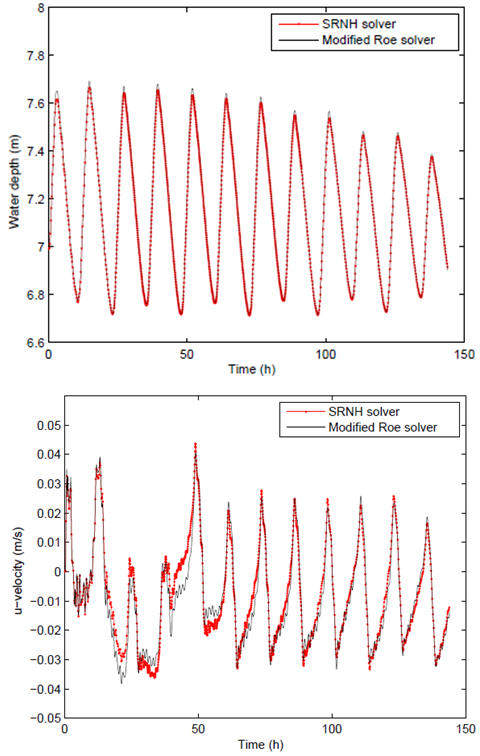-
Paper Information
- Paper Submission
-
Journal Information
- About This Journal
- Editorial Board
- Current Issue
- Archive
- Author Guidelines
- Contact Us
International Journal of Hydraulic Engineering
p-ISSN: 2169-9771 e-ISSN: 2169-9801
2014; 3(4): 111-119
doi:10.5923/j.ijhe.20140304.02
A Numerical Model for the Simulation of Water Recirculations in the Nador Lagoon (Morocco)
A. Yachouti1, S. Daoudi2, I. Elmahi1, F. Boushaba1
1Equipe de Modélisation et Simulation Numérique, ENSAO, Complexe universitaire, Oujda, Maroc
2Ecole Nationale des Sciences Appliquées d’Al-Hoceima, Maroc
Correspondence to: A. Yachouti, Equipe de Modélisation et Simulation Numérique, ENSAO, Complexe universitaire, Oujda, Maroc.
| Email: |  |
Copyright © 2014 Scientific & Academic Publishing. All Rights Reserved.
A finite volume solver is developed for the simulation of the hydrodynamic and water recirculation in the Nador lagoon. The physical model is based on the 2D shallow water equations that include slope variations and friction losses. The convective fluxes are approximated with a Non Homogeneous Riemann Solver (SRNH) on unstructured meshes, whereas an operator splitting procedure is used for the friction terms. Second-order accuracy in space is achieved through variable reconstruction. The algorithm can be applied to model flows on complicated geometries and preserves the balance between the pressure gradient and source term due to the slope variation. Numerical tests are presented here and discussed for the study of the water circulations in the Nador lagoon considering the new “pass” with the Mediterranean Sea.
Keywords: Shallow water equations, Finite volume, SRNH solver, Unstructured meshes, Water recirculation, Nador lagoon
Cite this paper: A. Yachouti, S. Daoudi, I. Elmahi, F. Boushaba, A Numerical Model for the Simulation of Water Recirculations in the Nador Lagoon (Morocco), International Journal of Hydraulic Engineering, Vol. 3 No. 4, 2014, pp. 111-119. doi: 10.5923/j.ijhe.20140304.02.
Article Outline
1. Introduction
- Lagoons are almost closed bodies connected loosely to the sea by narrow channels subjected to siltation and sediment obstruction. The hydrodynamic circulation pattern of these bodies is difficult to compute due to their usually complex geometry combined with the influence of the tides, the wind and the fresh water inputs coming from the rivers and streams of the lagoon watershed. From a biological point of view, lagoons can be characterized as complex ecosystems in a fragile equilibrium and their modeling is a difficult task as one has to take into account numerous interactions between physical, chemical and biological parameters.Lagoons have important environmental and societal aspects. They are extremely rich from a biological point of view as the reproduction area of a great number of species as well as the passage of many migratory bird species. Lagoons are also the siege of many human activities: urbanization, tourism, agriculture, fishing and shell-fishing farming all influencing the lagoon state in a complex way. Many lagoons are affected over the years by anthropogenic influences, including environmental degradation and local or global sources of pollution. The modelling of lagoon poses a lot of interesting and difficult questions to numerical analysis: The geometrical complexity of these areas requires the use of sophisticated two or three dimensional finite volume or finite element methods that are computationally very expensive and ask for adaptive meshes and parallel computing. Beside this, lagoon’s modelling is intrinsically a multi-physics problem. It therefore involves multiple spatial and temporal scales that have to be connected through parameterization as well as by well designed numerical tools.Among these lagoons, the Nador lagoon located on the North-East of Morocco is an ecosystem that is of great biological interest, ecological and economic. It covers an area that exceeds 120 Km2 and a maximum depth of 8m (see Figure 1), and is fed by water of the Mediterranean through a pass known as ‘Bokhana’, the freshwater waterways, the rejections of the untreated human activities (agriculture and urban water industry : metallurgy, textile …), and by water of the station of purification.
 | Figure 1. Schematic description of the Nador lagoon |
2. The Equations to be Solved
- The mathematical model can be derived by vertical integration of the three-dimensional incompressible Navier-Stokes equations along with the assumptions of a hydrostatic pressure and a vertically uniform horizontal velocity field, which results in the well-established shallow water equations written in conservative form as
 | (1) |
 ,
,  ,
, 
 ,
,  where x and y are the spatial coordinates, t is time, h is the height of the flow above the bottom Z, g is gravity acceleration, u and v are the velocity components in the x and y directions, and
where x and y are the spatial coordinates, t is time, h is the height of the flow above the bottom Z, g is gravity acceleration, u and v are the velocity components in the x and y directions, and  the water density.
the water density.  and
and  are the bed shear stress in the x and y direction, respectively, they are defined by the depth-averaged velocities as
are the bed shear stress in the x and y direction, respectively, they are defined by the depth-averaged velocities as  where Cb is the bed friction coefficient, which may be either constant or estimated as
where Cb is the bed friction coefficient, which may be either constant or estimated as  , where
, where  is the Chezy constant, with
is the Chezy constant, with  being the Manning coefficient at the bed.
being the Manning coefficient at the bed.3. Numerical Method
3.1. Mesh Generation and Bed Topography
- Let Ω be the domain of computation covered by a conformal grid consisting of a set of unstructured polygons K that are as general as possible. In this work the unstructured meshes are composed of triangles. Figure 2 shows the mesh of the Nador lagoon generated by using the Delaunay triangulation technique [12]. Since the boundary conditions in the Mediterranean part are not well known, the computational domain has been limited in this study to the pass between the lagoon and Mediterranean sea. In this way the tidal boundary conditions will be imposed at this pass.
 | Figure 2. Unstructured mesh of the Nador lagoon |
 | Figure 3. Bathymetry of the Nador lagoon |
3.2. Finite Volume Formulation
- Research on numerical solution of equations (1) has received considerable attention during the last decades and a several finite volume methods have been developed, compare [13-15] among others. The main advantages of these methods lie on their implementation on unstructured triangular meshes and preserving conservation properties of the equations. The computational code developed here uses the «cell-centred» finite volume formulation for which all the state variables are updated at the centroid of each cell (the centre of gravity in our case). Figure 4 illustrates the type of control volumes used.
 | Figure 4. A cell-centred control volume |
 | (2) |
 is the convective flux tensor defined by
is the convective flux tensor defined by N(i) is the set of neighbouring triangles of the cell
N(i) is the set of neighbouring triangles of the cell  is the edge separating control volumes Ti and Tj, and n=(nx,ny) denotes the unit vector normal to
is the edge separating control volumes Ti and Tj, and n=(nx,ny) denotes the unit vector normal to 
3.3. Discretization of the Convective and Bed Slope Source Terms
- The system of Saint-Venant equations (1) includes the variation of topography and therefore special attention should be paid to his numerical discretization. Indeed, a well known problem is that shallow-water equations on non-flat topography have steady-state solutions in which the flux gradients are non zero but are exactly balanced by the source terms. Standard numerical methods for the discretization of conservation laws may fail in correctly reproducing this balance (C-property, see e.g., [16]) and, thus, specific methods have been developed to deal with this problem (well-balanced schemes, see e.g., [16-18]).The method adopted herein for the space discretization has been proposed by Benkhaldoun, Elmahi, and Seaid in a series of papers (see for instance [10, 19]). It is based on a Riemann Solver, named SRNH, and consists of a predictor stage for which the state Wij at each edge
 is computed by solving a Riemann problem, and a corrector stage where the state Wn+1 at time tn+1 is reconstructed iteratively using the physical flux on Wij. The scheme considers only the advection part and the source term containing slope variations
is computed by solving a Riemann problem, and a corrector stage where the state Wn+1 at time tn+1 is reconstructed iteratively using the physical flux on Wij. The scheme considers only the advection part and the source term containing slope variations | (3) |
 yields:
yields: | (4) |
 and
and  are, respectively, the normal and tangential velocity.For this projected system, the predictor stage is then formulated, for the evaluation of the averaged state
are, respectively, the normal and tangential velocity.For this projected system, the predictor stage is then formulated, for the evaluation of the averaged state  on each edge
on each edge  , using an upwind scheme, in the following manner:
, using an upwind scheme, in the following manner: | (5) |
 ,
,  ,
,  In (5),
In (5),  is the intermediate Roe-averaged state given by
is the intermediate Roe-averaged state given by
 denotes the sign matrix of the Jacobean
denotes the sign matrix of the Jacobean , it is defined by:
, it is defined by: and
and
 and
and  are respectively the eigenvector and eigenvalue matrices of
are respectively the eigenvector and eigenvalue matrices of  .By incorporating these matrices in the predictor stage (5), the projected state
.By incorporating these matrices in the predictor stage (5), the projected state  on each edge
on each edge  can be easily obtained. The conservative state
can be easily obtained. The conservative state  is then evaluated using the transformations
is then evaluated using the transformations  and
and .Therefore, the incremental corrector stage is written using the non projected conservative states in the following manner:
.Therefore, the incremental corrector stage is written using the non projected conservative states in the following manner: | (6) |
 being the surface of the control volume
being the surface of the control volume  and
and  the length of the edge
the length of the edge  separating triangle
separating triangle  and
and  .In the corrector stage (6), the source term approximation is reconstructed in such a way to obtain a well balanced scheme preserving steady state at rest (see [10] for details on this reconstruction).
.In the corrector stage (6), the source term approximation is reconstructed in such a way to obtain a well balanced scheme preserving steady state at rest (see [10] for details on this reconstruction).3.4. Second Order Extension
- The SRNH scheme described above is first order accurate in space. It is monotone but has a poor accuracy due to the large amount of numerical dissipation. The extension to 2nd-order accuracy in space can be achieved by using a classical MUSCL technique [20]. In the definition of the flux in (6), we replace the piecewise constant values
 and
and  by more accurate reconstructions deduced from piecewise linear approximations, namely the values
by more accurate reconstructions deduced from piecewise linear approximations, namely the values  and
and  , reconstructed on both sides of the interface as follow/
, reconstructed on both sides of the interface as follow/ | (7) |
 denotes the gradient operator,
denotes the gradient operator,  and
and  are respectively the barycentres of cells
are respectively the barycentres of cells  and
and  .
.  is a parameter between 0 and 1. In practice one uses
is a parameter between 0 and 1. In practice one uses  The resulting scheme is second order in space but is not necessarily monotonous and non-physical oscillations are produced. To damp the numerical oscillations in the current computations, the Van Albada flux limiter is applied:
The resulting scheme is second order in space but is not necessarily monotonous and non-physical oscillations are produced. To damp the numerical oscillations in the current computations, the Van Albada flux limiter is applied: | (8) |
 | (9) |
 . With this limitation one obtains a monotonic second reconstruction for the hyperbolic part.
. With this limitation one obtains a monotonic second reconstruction for the hyperbolic part.3.5. Treatment of the Friction Terms
- The friction terms in (2) are discretized using an operator splitting procedure. For example, to evaluate the x-momentum, the second equation of the system (2) is split into two equations
 | (10) |
 is the Manning’s coefficient and Res describes the convection contributions in the x-momentum equation corresponding to the surface integral in eq. (2), and is approximated as the sum taken over all boundary segments.First, a semi-implicit method is used to integrate the upper equation in (10), giving
is the Manning’s coefficient and Res describes the convection contributions in the x-momentum equation corresponding to the surface integral in eq. (2), and is approximated as the sum taken over all boundary segments.First, a semi-implicit method is used to integrate the upper equation in (10), giving | (11) |
 is taken to be the initial condition when solving the second equation in (10).
is taken to be the initial condition when solving the second equation in (10).3.6. Explicit Time Advancing
- The spatial discretization of the convection and source terms leads generally to the following semi-discrete form:
 | (12) |
 is an approximation of the following discrete contributions:
is an approximation of the following discrete contributions:  To obtain an explicit scheme first-order accurate in time, the time-discretization can be carried out using an explicit Euler method, so that the resulting first-order numerical scheme is
To obtain an explicit scheme first-order accurate in time, the time-discretization can be carried out using an explicit Euler method, so that the resulting first-order numerical scheme is | (13) |
 | (14) |
4. Numerical Test
- The test case that we consider here consists in the study of the hydrodynamic and water circulations in the Nador lagoon. This test problem is interesting in the sense that it can give an answer to how the water moves into the lagoon, regions where the water recirculates and those where it stagnates. These last regions can be in fact very affected by contamination of wastewater coming from the city. The computations can also give an idea of the time residence of the water coming from the Mediterranean Sea before leaving the entrance of the lagoon.Initially, the flow is assumed to be at rest with constant free surface (h + Z = Cte). Two types of boundary conditions must be specified respectively at the pass between the Mediterranean Sea and the lagoon noted
 and land-type boundary located on the Nador coastlines
and land-type boundary located on the Nador coastlines  Hence the following boundary conditions
Hence the following boundary conditions  on
on  and
and  are imposed for the water flow and
are imposed for the water flow and | (15) |
 is the tidal amplitude at the entrance of the lagoon,
is the tidal amplitude at the entrance of the lagoon,  is the angular frequency of the tide, and
is the angular frequency of the tide, and  is the phase of the tide. In the Nador lagoon, the main astronomical tidal constituents are the semidiurnal M2, S2 and N2 tides, and the diurnal K1 tide. The values of the parameters
is the phase of the tide. In the Nador lagoon, the main astronomical tidal constituents are the semidiurnal M2, S2 and N2 tides, and the diurnal K1 tide. The values of the parameters  for each tidal wave are taken from [22] and are illustrated in table 1. Thus, the boundary condition on
for each tidal wave are taken from [22] and are illustrated in table 1. Thus, the boundary condition on  is replaced by
is replaced by | (16) |
 are time-dependent and should be updated at each time step according to the condition (16).
are time-dependent and should be updated at each time step according to the condition (16).
|
 chosen in such a way that the following stability condition is satisfied:
chosen in such a way that the following stability condition is satisfied: where
where  is the eigenvalue of the system, evaluated at the interface
is the eigenvalue of the system, evaluated at the interface  between two cells Ti and Tj, and CFL is the courant number taken here equal to 0.5 in order to ensure stability of the numerical scheme.In the figure 5, is presented the water height inside the lagoon. The computations have been performed for 6 days in physical times.
between two cells Ti and Tj, and CFL is the courant number taken here equal to 0.5 in order to ensure stability of the numerical scheme.In the figure 5, is presented the water height inside the lagoon. The computations have been performed for 6 days in physical times. | Figure 5. Water depth contours in the Nador lagoon |
 | Figure 6. Velocity field (top) and isolignes of u-velocity (bottom) in the case of high tides |
 | Figure 7. Velocity field (top) and isolignes of u-velocity (bottom) in the case of low tides |
 | Figure 8. Water depth and u-velocity versus time at gauged point G1 |
 | Figure 9. Water depth and u-velocity versus time at gauged point G2 |
 | Figure 10. Water depth and u-velocity versus time at gauged point G3 |
5. Conclusions
- In this paper, a numerical code based on the finite volume method has been applied for the simulation of the hydrodynamic and water circulations in the Nador lagoon. The method consists of two stages, which can be interpreted as a predictor–corrector procedure. In the first stage, the scheme uses the projected system of the coupled equations and introduces the sign matrix of the flux Jacobian, which results in an upwind discretization of the characteristic variables. In the second stage, the solution is updated using the conservative form of the equations and a special treatment of the bed bottom to obtain a well-balanced discretization of the flux gradients and the source terms. The solver is fully second order in space and time and can be used on complicated geometries with unstructured meshes. The test case presented here shows the good performance of the method and confirms its capability to provide accurate and efficient simulations for shallow water flows including complex topography and friction forces on unstructured grids. The next step of this work will consist in the study of the transport-dispersion of contaminant produced by the wastewater in the Nador lagoon. The results obtained in this paper for the hydrodynamic will be considered as an initial condition for the simulation of pollutant transport problem. A relevant study would also measure the residence time of water coming from the Mediterranean Sea into the lagoon in order to find a way to renew often, and thus make it less polluted. An adequate numerical study would determine the necessity and indeed the eventual location of another passes between the lagoon and the Mediterranean permitting to reduce the residence time of a given tracer.
 Abstract
Abstract Reference
Reference Full-Text PDF
Full-Text PDF Full-text HTML
Full-text HTML